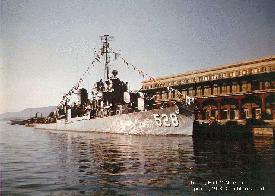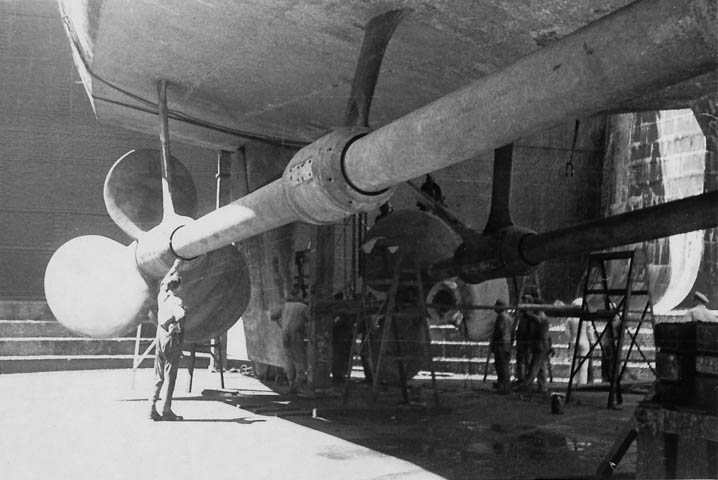Mediterranean

The Mullany came out of retirement on March 8, 1951. She had been moth balled in 1946 at Charleston, South Carolina. Frank Picard BT3/c a shipmate assigned to assist in reactivating the Mullany, recalls that after fives years of little or no maintenance, it was a messy and dirty job. All the machinery in the fwd and aft fire rooms, and fwd and aft engine rooms was covered with a grease like coating of the preservative Cosmoline. This had to be removed with diesel fuel. Topside was plagued with ugly pealing paint and rusty patches of steel. Frank also relates that after recommissioning the Mullany, the ship after passing south through the Cape Cod Canal, ran aground on a sand bar in Buzzards Bay and damaged the ships props. "Oh! Oh! better get Maaco!" It was back to the drawing board. The Mullany had to make its way slowly around Cape Cod to the Charlestown Navy Yards for repairs. Frank says the vibration was bad and the current in the canal would have been a problem.
The Mullany was assigned to Destroyer Squadron 18 with their home port being NewPort, Rhode Island. On or about April 15, 1952 the Mullany, along with Desron 18 ,departed for a six month deployment in the Mediterranean with the Sixth Fleet. The crew was told that we would be joining more ships at daybreak. The next morning I could not believe what I saw. Ships in all directions. I didn't know the Navy had so many ship.
On April 26, 1952 this armada of ships split into two groups for night time training maneuvers with each other. About 23:30 hours the watch woke me up for midnight duty. I remember his words verbatim. "Hey Nehls get up, on your way to sonar stop in at CIC and listen to the radio chatter. The USS Wasp (CV-18) just sank the USS Hobson (DMS-26) [formally DD-464, was converted and reclassified 15 November 1944]". My reply was, " your nuts, I'll be up in a short short". I stuck my head in CIC (Combat Information Center), he was right. The Hobson had crossed the bow of the Wasp from port to starboard, and was struck amidships while turning into the wind to recover aircraft. The Hobson was rolled over and broken in two. The USS Rodman and the Wasp saved many of the crew, but the Hobson and 176 of her crew were lost . From that point on I think most of the crews in the Sixth Fleet realized that our jobs at sea were serious business. We stayed alert. The Wasp returned to the Brooklyn Navy yards to have her bow repaired, and was back in the Mediterranean in about 45 days.
Another incident occurred about two month later, during night time maneuvers, and darkened ship (no running light). At about 22:00 hour Sonar reported a sonar contact dead astern with heavy screw sounds and getting louder...no range. The captain checked his sonar monitor on the bridge, checked with CIC and Radar. CIC reported no contact the ship was to close. The Captain ordered all ahead flank, standard right rudder, and all running light turned on. The carrier Wasp missed us by about 300 yards. We stayed alert.
During the height of the cold war while in Trieste, Italy The Mullany received orders to put to sea to escort cruisers. The Russians were amassing troops just across the border in Yugoslavia, during what they called annual maneuvers. While escorting the cruisers the Mullany reported a sonar contact moving at five knots and on a steady course. Fleet Command was notified, another destroyer was ordered to accompany the Mullany, and for three days the contact was tracked. On the third day we received orders from Washington to maintain contact and sink it if fired on.. The captain order the depth charges armed and set for depth, and the hedgehogs loaded. One of the Gunners mates asked the captain if they should use dummy hedge hogs. The captain's reply was, "Load'm for bear". A couple of hours later the Whale was spotted. That whale never varied its speed or heading for the entire time it was tracked. It was back to looking at the gray side of a cruiser.
The Mullany's second cruise to the Mediterranean was cut short by a problem with the port screw. In dry dock in Gibraltar it was determined that she would be required to return to the states for repairs. While in dry dock the sonar crew also found that a porpoise had rammed the sonar transducer and put a segment of the transducer out of commission. (We replaced a lot of vacuum tubes trying to fix that malfunction.) Eight years earlier the Mullany crossed the Pacific on one screw. Now she would cross the Atlantic on one screw escorting the USS Roosevelt. At one point during heavy weather the carrier wanted to launch planes, and turned into the wind. The Mullany started taking rolls near 45 degrees. (near capsizing) and notified the carrier that we could not keep up and would see them in three days after the storm.

After repairs in the Brooklyn Navy Yards, the Mullany was redeployed for her third cruise to the Mediterranean. It was much of the same thing that we had done before. Visiting ports from one end of the Mediterranean to the other, searching for submarines when under way, while at the same time screening for aircraft carriers.
We usually received mail once or twice a week by helicopter. Entertainment was usually movies that we had no control over. Usually the same movie was shown many times. When in port we would go from tin-can to tin-can and try to trade for a movie that had not been shown yet.
|